Topic 1: Ecosystems
Hello Student!
Today, we are going to learn about something called an Ecosystem. It sounds like a big word, but it's quite simple when we break it down. Think about the place where you live, the plants and animals around you, the water, the soil, the air – they are all connected! Let's find out how they are connected.
What is an Ecosystem?
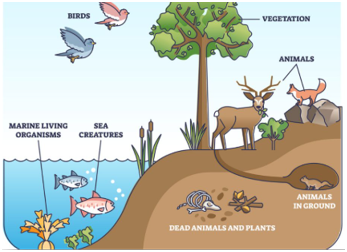
(Kuti Ecosystem zvinomboreveyi?)
- Imagine a place: Think about a river, or the bush (kasango) near your home, or even a small pond (ka fish pond).
- In that place, there are living things (zvinhu zvinofema): Like trees, grass, birds, mhuka (animals like impala or kudu), insects, fish (if it's water), and even tiny, tiny things we can't see easily.
- There are also non-living things (zvinhu zvisingafemi): Like the sun, the water, the air, the soil (earth), and rocks.
- They all connect and work together (zvinoshandidzana): The living things need the non-living things to live. The living things also affect each other (like animals eating plants, or birds nesting in trees).
So, an Ecosystem is:
A place where living things (like plants and animals) and non-living things (like water, sun, soil) all live together and depend on each other.
It's like a big team or a community where everyone and everything has a part to play.
(Think of it like your home: You have people (living), but you also need the house itself, water, air, maybe a cooking fire (non-living things) to live properly. Everyone and everything works together.)
What Makes Up an Ecosystem? (The Parts)
(Zvii zvinowanikwa muEcosystem?)
An ecosystem has two main types of parts, or components:
1. Living Things (Biotic Components)
This means anything that is alive! (chinhu chese chine hupenyu)
Examples:
- Plants: Trees (like Musasa, Mopane, Mango tree, Gum tree), grass, bushes, vegetables, algae (zvima plants zve green zvaunoona mumvura). Plants make their own food using sunlight!
- Animals (Mhuka/Zvipuka): Impala, elephants, lions, birds (like eagles, doves), fish, frogs, insects (like majuru - termites, mosquitoes), worms (makonye) in the soil. Animals get food by eating plants or other animals.
- Tiny Living Things (Micro-organisms) (tupuka tudiki diki): These are very, very small things like bacteria or fungi (kunge futi se tsikidzi). We often can't see them, but they are important for breaking down dead plants and animals in the soil.
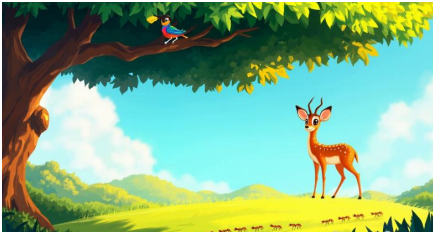
2. Non-Living Things (Abiotic Components)
This means anything in the ecosystem that is NOT alive. But the living things NEED them! (chinhu chisina hupenyu asi zvine hupenyu zvinotochida kuti zvirarame)
Examples:
- Sunlight (Zuva): Gives light and heat. Plants need sunlight to make food. Animals need warmth.
- Water (Mvura): All living things need water to drink or live in. Plants need it to grow.
- Air (Mhepo): Animals and plants need air to breathe (oxygen).
- Soil (Ivhu): Plants grow in soil. Many small animals and tiny living things live in the soil. It holds water and nutrients for plants.
- Temperature (Kupisa/Kutonhora): How hot or cold it is affects what plants and animals can live there.
- Rocks and Land shape: Provides shelter or places for plants to grow.
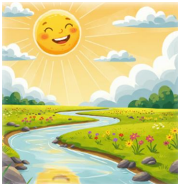
How they connect: The living things depend on the non-living things. Plants need sun, water, air, soil. Animals need water, air, plants or other animals (which need plants!), and shelter (sometimes from rocks or land). Everything is linked!
Natural Ecosystems
(MaEcosystem Akango Zviwanikirawo Zvawo)
- "Natural" means something that is found in nature, not made or greatly changed by people. (zvinhu zvisina kugadzirwa nevanhu, zvakangogara zviriko in other words Zvakasikwa na)
- A natural ecosystem is a place that works on its own, with its own living and non-living parts connected, without humans managing it too much.
Examples of Natural Ecosystems in Zimbabwe:
- Savanna / Bushveld (Masango / Renje): Large areas with grass, scattered trees, and animals like elephants, zebras, lions, impala. Think of Hwange National Park or Gonarezhou. The sun, rain, soil, plants, and animals all work together naturally.
- Forests: Areas with many trees close together. Like the forests in the Eastern Highlands (Vumba, Nyanga). They have special plants, birds, and animals living there.
- Rivers and Lakes (Nzizi neMadziva): Like the Zambezi River or Lake Kariba. They have fish, crocodiles, hippos, water birds, algae, and the non-living water, rocks, and sunlight creating a water ecosystem.
- Wetlands / Dambos (Matoro): Areas that are often wet, with special grasses and reeds. Important for water storage and many birds and frogs.
Key idea: In a natural ecosystem, the plants, animals, sun, water, soil are all balanced. Humans didn't create it like a farm (purazi) or a city park. It developed over a long, long time by itself.
Let's Summarise (Part 1):
- Ecosystem: A place with living and non-living things interacting (depending on each other).
- Components: Ecosystems have Living Things (plants, animals, tiny things) and Non-Living Things (sun, water, air, soil, temperature).
- Natural Ecosystem: An ecosystem made by nature, not mainly by people (like a savanna, forest, or river).
Let us continue our journey into understanding Ecosystems. We know what an ecosystem is and its parts (living and non-living). Now, let's see how energy moves through the living parts. It's mostly about eating!
Topic: Food Chains, Food Webs, and Pyramids - How Energy Moves
Remember we talked about living things (plants, animals) in an ecosystem? Well, all living things need energy to live, grow, and move. Plants get energy from the sun. Animals get energy by eating plants or other animals.
We are going to learn about how this energy passes from one living thing to another. We will look at:
- Food Chains: A simple line showing who eats who.
- Food Webs: Many food chains connected together.
- Pyramids of Biomass: Showing how much "living stuff" there is at each step.
Food Chains (Who Eats Who?)
(Kuti ndechipi chinodya chimwe?)
- What is it? A food chain shows how energy passes from one living thing to another when it gets eaten. It's like a simple line showing the path of food.
- How does it start? It almost always starts with a plant. Plants are special because they make their own food using sunlight, water, and air. We call them Producers.
- Example Producers: Grass, Trees (like Musasa), Maize plants, Algae (in water).
- Who eats the plants? Animals that eat plants are called Herbivores or Primary Consumers. (Primary means first).
- Example Primary Consumers: Impala eating grass, mbeva (mouse) eating seeds, grasshoppers eating leaves, Zebra eating grass.
- Who eats the herbivores? Animals that eat other animals are called Carnivores. Animals that eat herbivores are called Secondary Consumers. (Secondary means second).
- Example Secondary Consumers: A snake eating a mouse, a bird eating a grasshopper, a lion eating an impala.
- Who eats the carnivores? Some carnivores eat other carnivores. These are called Tertiary Consumers. (Tertiary means third).
- Example Tertiary Consumers: An eagle eating a snake (that ate a mouse).
- What about animals that eat BOTH plants and animals? (mhuka dzinodya ma greens nenyama ka1) We call them Omnivores. (Humans can be omnivores, baboons are omnivores). They can be primary, secondary, or even tertiary consumers depending on what they are eating at the time.
- The Arrows: In a food chain, we use arrows (→) to show the direction the energy is moving. The arrow points from the thing being eaten to the thing that eats it. (arrow unoitanga ku drawer wakabaka baya chiri kudyiwa wonotendeka chiri kuchidya chacho)
Let's Build a Food Chain (Example) (kana ukanzi drawer food chain unoita so):
- Start with a Producer: Grass (makes food from sun (producer chinhu chinozvigadzirira chikafu, hachina need yekudya chimwe))
- Add a Primary Consumer (eats the producer): Impala (eats grass)
- Add a Secondary Consumer (eats the primary consumer): Lion (eats impala)

So the food chain looks like this:
Grass → Impala → Lion
(ma arrows ayo arikuto tendeka chiri kudya chacho sapa unotowona kuti grass rinodyiwa ne impala, impala yacho inodyiwa ne Lion)
Another Example:
Maize Plant → Mouse (Mbeva) → Snake (Nyoka) → Eagle (Gondo)
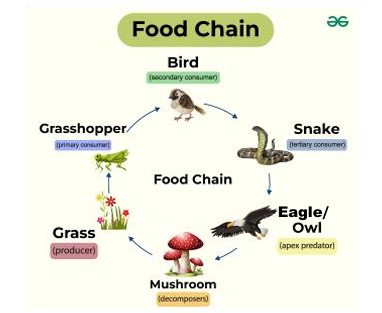
Food Webs (Many Food Chains Together)
(Masangano Ezvikafu - Zvinodyiwa Zvakawanda)
- What is it? In nature, things are usually more complicated than a single food chain. Most animals eat more than one type of food. And many animals are eaten by more than one type of predator. A Food Web shows how lots of different food chains connect together in an ecosystem. It looks more like a spider's web! (food web inoratidza mhuka nema plants nemhuka dzinodya dzimwe uye panenge pane ma arrow anoratidza sekuti grass rikudyiwa nembudzi poita kana pane imwe mhuka se impala unotoisa futi arrow ichibva pa grass ichienda pa impala. Kana pakaita futi shumba unoisa arrow ichibva pa mbudzi ichinongedza shumba woisa imwe paImapa ichinongedza pashumba)
- Why is it useful? It gives a better picture of how energy moves around in a real ecosystem.
Let's Build a Simple Food Web (Example):
Let's use our examples from before and add more connections:
- Grass is eaten by Impala AND Mice.
- Mice are eaten by Snakes AND Eagles.
- Impala are eaten by Lions.
- Snakes are eaten by Eagles.
So the food web would show arrows like this:
- Grass → Impala
- Grass → Mouse
- Impala → Lion
- Mouse → Snake
- Mouse → Eagle
- Snake → Eagle
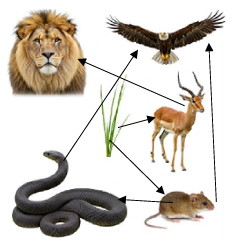
You see how the Mouse is connected to Grass, Snake, and Eagle? The Eagle is connected to Mouse and Snake? It's all linked up.
Key Idea: Food webs show that if one food source disappears, an animal might still have something else to eat. It shows the ecosystem is connected in many ways.
Pyramids of Biomass
(Chirongwa Cheuwandu Hwezvipenyu - Biomass Pyramid)
- First, what is Biomass? Biomass means the total amount (like the total weight) of living things in a certain area or at a certain level in the food chain.
- What is a Pyramid of Biomass? It's a drawing shaped like a pyramid (like the pyramids in Egypt, wide at the bottom, narrow at the top). It shows the total biomass at each level of a food chain.
How it Works (The Levels):
- Base Level (Bottom): Producers (Plants)
- Plants make their own food from the sun. There needs to be a LOT of plants (grass, trees) to support everything else. So, the biomass of producers is the biggest. This forms the wide base of the pyramid.
- Next Level Up: Primary Consumers (Herbivores)
- These animals eat the plants. Think about it: the total weight of all the impala in an area is much LESS than the total weight of all the grass they eat. Why? Because energy is lost when the impala lives, moves, breathes, and not all the grass is turned into impala body parts! So, the biomass of primary consumers is smaller than the producers. This level is narrower.

- Next Level Up: Secondary Consumers (Carnivores eating herbivores)
- These animals eat the herbivores. The total weight of all the lions is much LESS than the total weight of all the impala they eat. Again, energy is lost. So, the biomass of secondary consumers is even smaller. This level is narrower still.
- Top Level: Tertiary Consumers (Top Carnivores)
- These animals are at the top. The total weight of all the eagles (eating snakes) is much LESS than the total weight of the snakes they eat. So, the biomass here is the smallest. This forms the pointy top of the pyramid.
Why the Pyramid Shape?
Because energy is lost at each step (or level) of the food chain. When an animal eats something, only a small part (maybe 10%) of the energy from the food is used to build its own body (biomass). The rest is used for living (running, breathing) or lost as heat. So, there is less energy and less biomass available as you go higher up the food chain.
Key Idea: The pyramid shows that you need a large amount of plants at the bottom to support a smaller amount of herbivores, which support an even smaller amount of carnivores.
Now Let's Connect Everything:
- A Food Chain is one path of energy (Grass → Impala → Lion).
- A Food Web shows many connected food chains, giving a real picture of who eats what.
- A Pyramid of Biomass shows the amount of living matter decreases as you go up the levels in a food chain or food web, because energy is lost at each step.
Understanding these helps us see how energy flows in nature and how all the living things depend on each other, starting from the plants capturing the sun's energy!
Okay, let's keep learning about how ecosystems work! We've talked about who eats who (food chains/webs) and how much living stuff there is (pyramids). Now let's look closer at energy and some important cycles, plus different types of ecosystems and why variety is important.
Topic: Energy Flow, Cycles, and Biodiversity
How Energy is Lost in Food Chains and Food Webs
(Mashandisiro uye Kurasika kweSimba mumaFood Chains nemaFood Webs)
Remember the Pyramid of Biomass? It gets smaller at the top. This is because energy is lost at each step when something eats something else.
Think about an impala eating grass:
- Not all parts are eaten: The impala doesn't eat the roots of the grass. Some energy stays in the uneaten parts.
- Not all eaten parts are used: When the impala digests the grass, some parts cannot be broken down and pass out as waste (ndove - dung). The energy in that waste is lost to the impala.
- Energy used for Living: The impala needs energy just to live! It uses energy to:
- Walk and run (kufamba nekumhanya)
- Breathe (kufema)
- Keep its body warm (kudziya)
- Grow and repair its body
The Rule: Only a small amount (maybe only 1 part out of 10!) of the energy from the food an animal eats is actually used to build its own body (biomass). The rest is used for living or is lost.
So, in a food chain (Grass → Impala → Lion):
- The Impala gets only a small bit of the Grass's total energy.
- The Lion gets only a small bit of the Impala's total energy.
This is why:
- There is much more grass than impala.
- There are many more impala than lions.
- Food chains cannot be very long – there isn't enough energy left after just a few steps!
In a Food Web: The same thing happens along every arrow. Energy is lost at every single step where something is eaten.
Important Cycles in Nature - Moving Materials Around
(Kutenderera Kwezvinhu Zvinokosha MuNharaunda)
Living things need more than just energy. They need materials like Carbon and Nitrogen to build their bodies. These materials are used over and over again – they move in cycles.
A. The Carbon Cycle (Kutenderera kweCarbon)
- What is Carbon? It's a basic building block of all living things (plants, animals, us!). It's found in the air as a gas called Carbon Dioxide (CO2).
- How it moves:
- Plants take Carbon from the Air: Plants use sunlight energy to take CO2 from the air (mhepo) and water (mvura) to make their food (sugars, starches). This is called Photosynthesis. The carbon becomes part of the plant.
- Animals get Carbon by Eating: When animals eat plants (or eat animals that ate plants), the carbon moves into their bodies.
- Living Things Release Carbon by Breathing: Both plants and animals release CO2 back into the air when they break down food for energy. This is called Respiration (kufema).
- Dead Things Return Carbon: When plants and animals die, tiny decomposers (like bacteria and fungi in the soil - vhu) break down their bodies. This releases carbon back into the soil and CO2 back into the air.
- Burning Releases Carbon: When things like wood, grass, petrol, or coal are burned (kupisa), the carbon in them combines with oxygen and is released quickly as CO2 into the air.
- The Cycle: Air (CO2) → Plants → Animals → Dead Organisms/Soil → Air (CO2). Breathing and burning also release CO2 back to the air. It goes round and round!
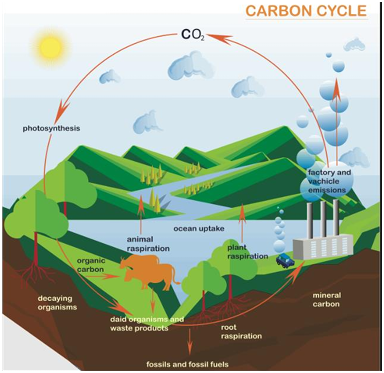
B. The Nitrogen Cycle (Kutenderera kweNitrogen)
- What is Nitrogen? It's another essential element needed by living things, especially to build proteins (which make muscles and help bodies work). The air we breathe is mostly Nitrogen gas (N2).
- The Problem: Most plants cannot use the Nitrogen gas directly from the air. It needs to be changed into forms they can absorb from the soil.
- How it moves:
- Nitrogen Fixation (Changing Nitrogen Gas): Special bacteria (tiny living things) in the soil and in the roots of some plants (like beans - nyemba, peas, groundnuts - nzungu) can take Nitrogen gas from the air and change it into nitrogen compounds (like nitrates) that plants can use. Lightning also fixes some nitrogen.
- Plants Absorb Nitrogen from Soil: Plants take up these nitrogen compounds from the soil through their roots. They use it to grow and make proteins.
- Animals get Nitrogen by Eating: Animals get nitrogen by eating plants or other animals.
- Dead Things Return Nitrogen to Soil: When plants and animals die, decomposers (bacteria and fungi) break down their bodies and waste products (ndove, urine). This returns nitrogen compounds back into the soil.
- Returning Nitrogen Gas to Air: Other special bacteria in the soil can change the nitrogen compounds back into Nitrogen gas, which goes back into the air. This is called Denitrification.
- The Cycle: Air (N2 Gas) → Soil Bacteria (Fixation) → Plants → Animals → Dead Organisms/Soil (Decomposition) → Soil Bacteria (Denitrification) → Air (N2 Gas). It also goes round and round!

Key Players: Bacteria are very, very important in the Nitrogen Cycle!
Artificial Ecosystems (Zvinhu Zvakagadzirwa neVanhu)
- Remember Natural Ecosystems (like savanna, forest, river) that work on their own?
- An Artificial Ecosystem is one that is created or managed by humans. It doesn't usually run by itself; it needs people to look after it.
- Examples:
- A Farm (Purazi) or Garden: Humans choose what plants to grow (chibage - maize, vegetables). They might add water (irrigation), fertilizer (manyowa), and remove weeds or pests. The food web is very simple (Crop → Human or Crop → Pest → Human).
- A Fish Pond (Dhamu rehove riri pamusha): People dig the pond, put in specific fish, often feed the fish, and manage the water.
- An Aquarium (Fish Tank): A small, closed glass tank with water, fish, maybe some plants. Humans control everything: food, water changes, light, temperature.
- A City Park: Humans plant the trees and grass, cut the grass, water it.
- Differences from Natural Ecosystems:
- Usually have less variety of plants and animals (low biodiversity).
- Need human help (energy, water, nutrients).
- Food chains are often short and simple.
- Less stable – if humans stop managing them, they change or collapse.
Biodiversity - The Variety of Life
(Kusiyana-siyana kweZvipenyu - Biodiversity)
- What is it? "Bio" means life. "Diversity" means variety or different kinds.
- Biodiversity simply means the variety of different living things found in a particular place (an ecosystem or even the whole Earth).
- This includes:
- Variety of species (different kinds of plants, animals, fungi, bacteria – like having impala, zebra, lions, different birds, different trees all together).
- Variety within a species (like different breeds of cattle - Mashona, Tuli; or different types of mangoes).
- Variety of ecosystems (like having savanna, forests, and wetlands all in one country).
- Think of it like this: A place with high biodiversity has LOTS of different types of living things. A place with low biodiversity has only a few types. (A natural forest usually has high biodiversity; a maize field has low biodiversity).
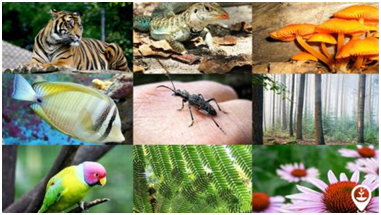
Problems Caused by Limited (Low) Biodiversity
(Kana pakasaita zvirimwa or mhuka dzakasiyanya dziyana, dzikangoita same type zvinoudza ma problems api)
When there isn't much variety, ecosystems become weak and face problems:
- Diseases Spread Easily: If all the plants or animals are very similar (like planting only one type of maize), a single disease can spread very quickly and wipe out almost everything. If there is variety, some types might be resistant and survive.
- Unstable Food Webs: If animals rely on only one or two types of food, and something happens to that food (like drought kills a specific plant), those animals might starve. In a diverse web, they might have other food options.
- Ecosystem Less Able to Cope with Change: Places with low biodiversity find it harder to recover from problems like drought (kusanaya kwemvura), floods, or new pests. There aren't enough different species to adapt or fill the gaps left by those that die.
- Loss of Useful Resources: Variety in nature gives us many things – different foods, wood, potential medicines hidden in plants we haven't studied yet. Low biodiversity means fewer options and potential discoveries are lost.
Advantages of Biodiversity (Why Variety is Good!)
(Kana pakaipa zvirimwa kana mhuka dzakasiyana siyana zviri muuwandu zvakanakireyi)
Having lots of different types of living things (high biodiversity) is very good for ecosystems and for us:
- Ecosystem Stability and Strength: Diverse ecosystems are stronger. They can handle changes better. If one species is affected by disease or drought, others can take over its role, keeping the ecosystem working. It's like having a team with many different skills!
- More Reliable Food Sources: Variety means more types of food available within the food web.
- Better Resistance to Disease: Diseases don't spread as easily when there are many different types of plants and animals.
- Healthy Soil and Water: Different plants, animals, and microbes work together to cycle nutrients (like nitrogen) efficiently, keep soil fertile (vhu rakanaka), and help clean water (like in wetlands).
- Provides Resources for Humans: Biodiversity gives us:
- A wide range of foods.
- Medicines (many drugs come from plants).
- Materials (wood, fibres).
- Services like pollination (bees need different flowers), clean air and water.
- Places for recreation and tourism (nzvimbo dzekushanyira).
In short: Biodiversity makes nature strong, healthy, and useful!
Let's Summarise Today:
- Energy is lost at each step in a food chain (used for living, not all eaten/digested).
- Carbon and Nitrogen move in cycles between the air, soil, plants, and animals. Bacteria are key for the Nitrogen cycle.
- Artificial ecosystems (farms, ponds) are made by humans and need management.
- Biodiversity is the variety of life.
- Low biodiversity makes ecosystems weak (disease spreads, unstable food webs).
- High biodiversity makes ecosystems strong, stable, and provides many benefits.
